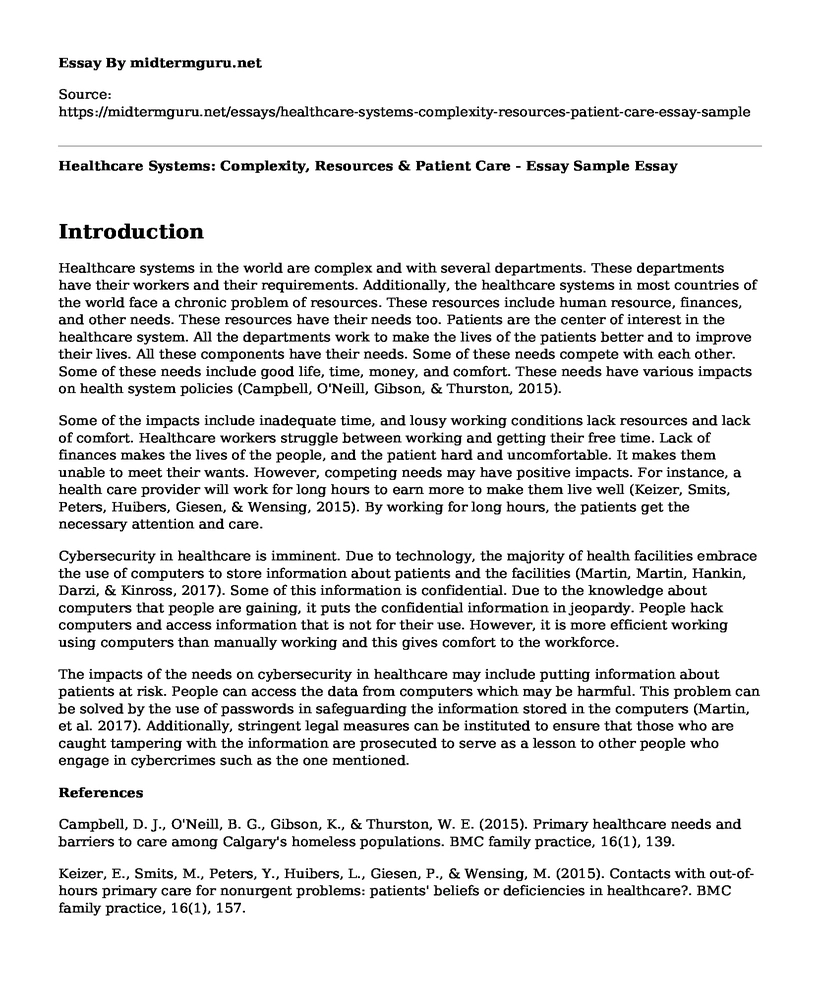Introduction
Healthcare systems in the world are complex and with several departments. These departments have their workers and their requirements. Additionally, the healthcare systems in most countries of the world face a chronic problem of resources. These resources include human resource, finances, and other needs. These resources have their needs too. Patients are the center of interest in the healthcare system. All the departments work to make the lives of the patients better and to improve their lives. All these components have their needs. Some of these needs compete with each other. Some of these needs include good life, time, money, and comfort. These needs have various impacts on health system policies (Campbell, O'Neill, Gibson, & Thurston, 2015).
Some of the impacts include inadequate time, and lousy working conditions lack resources and lack of comfort. Healthcare workers struggle between working and getting their free time. Lack of finances makes the lives of the people, and the patient hard and uncomfortable. It makes them unable to meet their wants. However, competing needs may have positive impacts. For instance, a health care provider will work for long hours to earn more to make them live well (Keizer, Smits, Peters, Huibers, Giesen, & Wensing, 2015). By working for long hours, the patients get the necessary attention and care.
Cybersecurity in healthcare is imminent. Due to technology, the majority of health facilities embrace the use of computers to store information about patients and the facilities (Martin, Martin, Hankin, Darzi, & Kinross, 2017). Some of this information is confidential. Due to the knowledge about computers that people are gaining, it puts the confidential information in jeopardy. People hack computers and access information that is not for their use. However, it is more efficient working using computers than manually working and this gives comfort to the workforce.
The impacts of the needs on cybersecurity in healthcare may include putting information about patients at risk. People can access the data from computers which may be harmful. This problem can be solved by the use of passwords in safeguarding the information stored in the computers (Martin, et al. 2017). Additionally, stringent legal measures can be instituted to ensure that those who are caught tampering with the information are prosecuted to serve as a lesson to other people who engage in cybercrimes such as the one mentioned.
References
Campbell, D. J., O'Neill, B. G., Gibson, K., & Thurston, W. E. (2015). Primary healthcare needs and barriers to care among Calgary's homeless populations. BMC family practice, 16(1), 139.
Keizer, E., Smits, M., Peters, Y., Huibers, L., Giesen, P., & Wensing, M. (2015). Contacts with out-of-hours primary care for nonurgent problems: patients' beliefs or deficiencies in healthcare?. BMC family practice, 16(1), 157.
Martin, G., Martin, P., Hankin, C., Darzi, A., & Kinross, J. (2017). Cybersecurity and healthcare: how safe are we?. Bmj, 358, j3179.
Cite this page
Healthcare Systems: Complexity, Resources & Patient Care - Essay Sample. (2023, Feb 09). Retrieved from https://midtermguru.com/essays/healthcare-systems-complexity-resources-patient-care-essay-sample
If you are the original author of this essay and no longer wish to have it published on the midtermguru.com website, please click below to request its removal:
- Executive Summary on Hospital Readmission - Paper Example
- Paper Example on Pro-Life Pregnancy Outreach Center for Teens and Single Adult Families
- Compare and Contrast Essay on Healthy versus Unhealthy Communities
- Financial Industry Evolves: Digital Banking Revolution - Essay Sample
- Professional Communication & Personal Effectiveness in Nursing - Essay Sample
- Essay Sample on Diabetic Ketoacidosis (DKA)
- Essay Sample on Harvesting Embryonic Stem Cells for Medical Research







